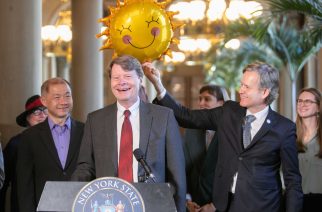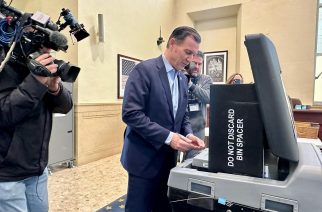Legislative Gazette video produced by Emily Ohlhoff and Austin Fearnley
Green gubernatorial candidate Howie Hawkins wants to tax the rich to pay for his Green New Deal program for revitalizing public infrastructure and services.
Hawkins said during an October 10 press conference in Albany that New York needs to invest on the order of $45 billion a year over the next decade to build a 100% clean energy system, to repair and upgrade the state’s infrastructure after decades of under-investment, and to fully fund education from universal pre-K through tuition-free education in the SUNY and CUNY systems.
Hawkins also said he wants the state to pick up the tab for its unfunded mandates and restore state revenue sharing so that local governments can provide better services while cutting regressive property and sales taxes.
“New York can afford these public investments if the rich pay taxes at the rates they did in the 1970s,” said Hawkins, a retired Teamster from Syracuse. “Forty years of conservative fiscal policies promoted by both major parties have combined tax cuts for the rich with spending cuts on public services and infrastructure. This trickle-down economics hasn’t worked. They gave more money to the rich but it didn’t trickle down to the rest of us. It just made the rich richer.
“The upstate economy remains depressed,” Hawkins noted. “The whole state suffers from failing infrastructure, from the MTA and NYCHA to the more than 1,800 structurally deficient bridges across the state and crumbling water and sewer lines in our cities. Our fiscally distressed counties, cities, and towns cannot afford to provide good services. The tax burden has shifted from the progressive income tax to regressive local property and sales taxes. The state balances its budget on the backs of local property taxpayers through unfunded mandates,” Hawkins said.
Hawkins noted that the share of income going to the top 1 percent has grown from 12 percent in 1980 to 31 percent today. The top 1 percent had $375 billion in income last year.
“Raising taxes on the top 1 percent by 10 percent would generate nearly $40 billion in new revenue – and the very wealthy would remain very wealthy,” Hawkins said.
Hawkins wants to make the state income tax more progressive, retain rather than rebate the stock transfer tax, and claw back the Trump federal corporate tax cut windfall where it is not used by New York companies to raise wages and create new jobs.
Hawkins also called for ecological taxes on the use, or abuse, of limited natural resources. He supports congestion pricing for cars on scarce lower Manhattan land to help fund needed upgrades to the New York public transit system. He supports a progressive carbon tax — with rebates for low-income households — to make fossil fuel polluters pay for their abuse of the atmosphere by greenhouse gases and help fund the transition to 100% clean energy.
“We will lower the costs of living and doing business in New York through public provision of good services and infrastructure. That includes single-payer health care, public power, public broadband, and a state public bank. Costs will also be lowered through property tax cuts from increased state revenue sharing,” Hawkins said.
“ We can improve the business climate with good public investments that benefit everyone much better than we have with top-end tax cuts that only benefited wealthy families and corporations. Public services and infrastructure are the public avenues that enable private commerce to thrive,” Hawkins added.
Hawkins supports the New York Health Act, which would provide all medically necessary services to all New Yorkers through a single public payer. The annual cost ranges from $254 billion in a study by economist Gerald Friedman to $310 billion in a Rand Corporation study. Hawkins dismissed the concerns raised by those who oppose it as a radical increase in the size of government. Friedman estimated the annual savings in overall health care costs in New York at $45 billion.
More than 90 percent of New Yorkers will pay less in taxes for health care than they now pay in taxes, premiums, deductibles, co-pays, and fees for uncovered services,” Hawkins said.
Hawkins also favors a state public bank that would lower the costs of financing public infrastructure, private business, and mortgages and other consumer loans due to lower interest rates.
“It is more fiscally responsible to tax the wealthy upfront than borrow money from them by bonding and paying interest to them for it. But the scale of investments we must make immediately to address the climate emergency and our failing infrastructure will require borrowing. We should borrow from ourselves through a state bank on the model of the state Bank of North Dakota,” said Hawkins.
Hawkins noted that public banking can finance public infrastructure for as little as half the cost of going to Wall Street because it bypasses the fees, commissions, and interest that would go to Wall Street banks. It uses the state’s own deposits as reserves for loans and receives the interest back into the public treasury.
Hawkins provided a list the estimated costs and revenue sources for the Green New Deal. “This list is not a detailed tax and budget plan. It is a back-of-the-envelope estimate to illustrate the scale of our public investment needs and how progressive and ecological taxes can provide the revenues needed to meet those needs,” Hawkins said.









